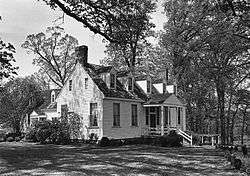Wigwam (Chula, Virginia)
The Wigwam is a landmark home, of cape cod style, built in 1790, close to the Appomattox River near Lodore on Rt. 637 (Giles Road), in Amelia County, Virginia. Virginia Governor William Branch Giles (1762-1830) built the house and made it his home until his death.[3][4]
Wigwam | |
 The Wigwam – home of Virginia Governor William Branch Giles and the Harrison family | |
  | |
| Location | 4 mi (6.4 km) northeast of Lodore, Virginia |
|---|---|
| Coordinates | 37°28′53″N 77°59′21″W |
| Area | 0 acres (0 ha) |
| NRHP reference No. | 69000220[1] |
| VLR No. | 004-0003 |
| Significant dates | |
| Added to NRHP | November 25, 1969 |
| Designated VLR | May 13, 1969[2] |
History
The original 18th-century building included only the back section, with the more formal front being added in 1818.[5] There is some information that the front section was originally relocated from the John Royall estate, called Caxamelalea. However, experts from Williamsburg have refuted this based upon their inspection of the house. It has 18 rooms and at one time had 5 full baths. There are 4 chimneys that serve 13 fireplaces, and 65 windows, 17 of which are dormers. One room in the basement appears to have been used to hold Yankee prisoners in the American Civil War; the room has a barred window and evidence of shackles on the wall.[6]
In 1832, Giles' son conveyed the Wigwam to a descendant of the Harrison family of Virginia, William Henry Harrison.[3] Harrison, with his wife Lucy (née Powers), raised six children there, and established a school for boys in the home named Amelia Academy. The Christian school was run, principally, to prepare its students for entrance to the University of Virginia in Charlottesville. The school's 1859–1860 flyer indicated a census of 25 pupils, and the school's board members included John Hartwell Cocke.[3]
In his final years running the school, William Henry was assisted by his eldest son, J. Hartwell Harrison, who later phased out the school and made the Wigwam his home with wife Anna (née Carrington) and their six children. After his return from the Civil War, Hartwell farmed the property and became the area's local Baptist minister.
The devastating effects of the Long Depression ultimately resulted in a mortgage default in 1896, and the family's eviction from the home by Hartwell's brother-in-law, Lewis Harvie Blair. In the mid 1900s, the property was owned and renovated by Hartwell's son, Robert N. Harrison.[3]
The Wigwam was added to the National Register of Historic Places in 1969.[1] In the 1990s the home and farm underwent major renovations by new ownership.
Notes
- "National Register Information System". National Register of Historic Places. National Park Service. July 9, 2010.
- "Virginia Landmarks Register". Virginia Department of Historic Resources. Retrieved 2013-05-12.
- Hooker, Mary Harrison (1998). All Our Yesterdays. Boca Grand. pp. 34–57.
- Virginia Historic Landmarks Commission Staff (n.d.). "National Register of Historic Places Inventory/Nomination: Wigwam" (PDF). and Accompanying photo
- Virginia. Dept. of Historic Resources (1999). Calder Loth (ed.). The Virginia Landmarks Register. University of Virginia Press. p. 35. ISBN 978-0-8139-1862-4.
- "The Wigwam". Amelia News Journal. 1997. Cite journal requires
|journal=(help)